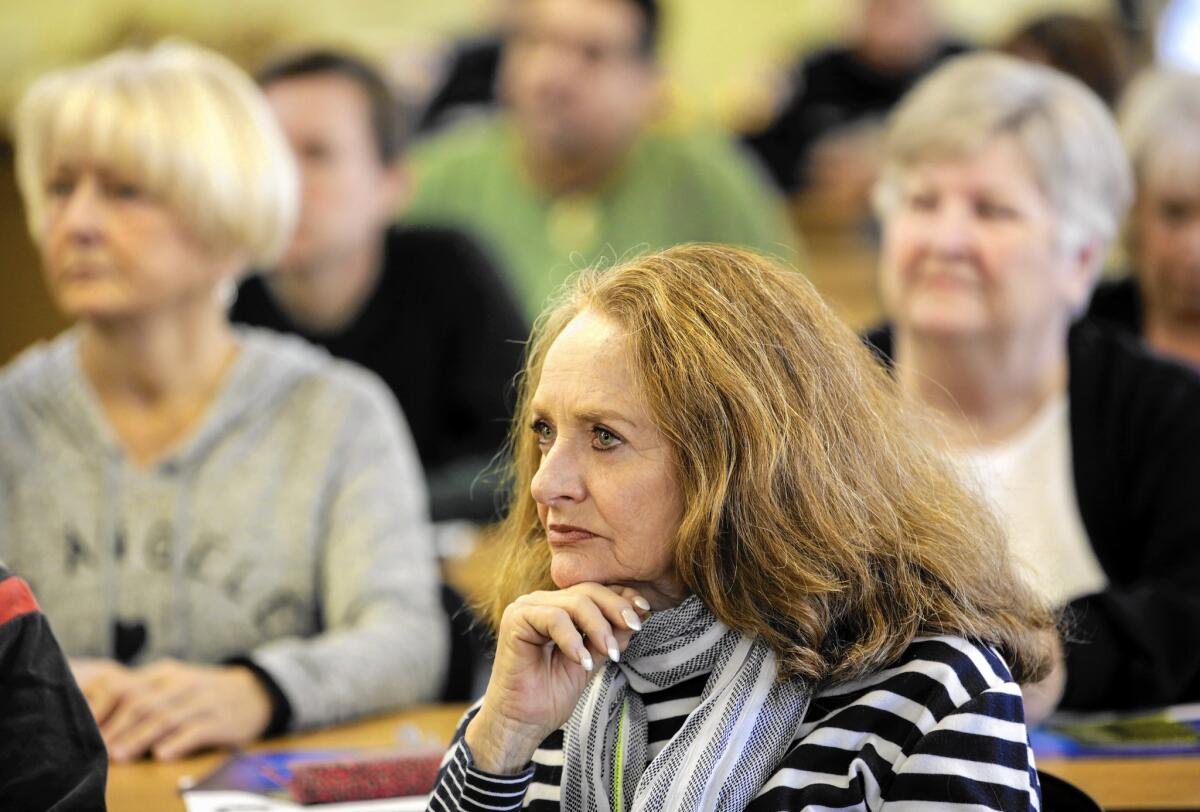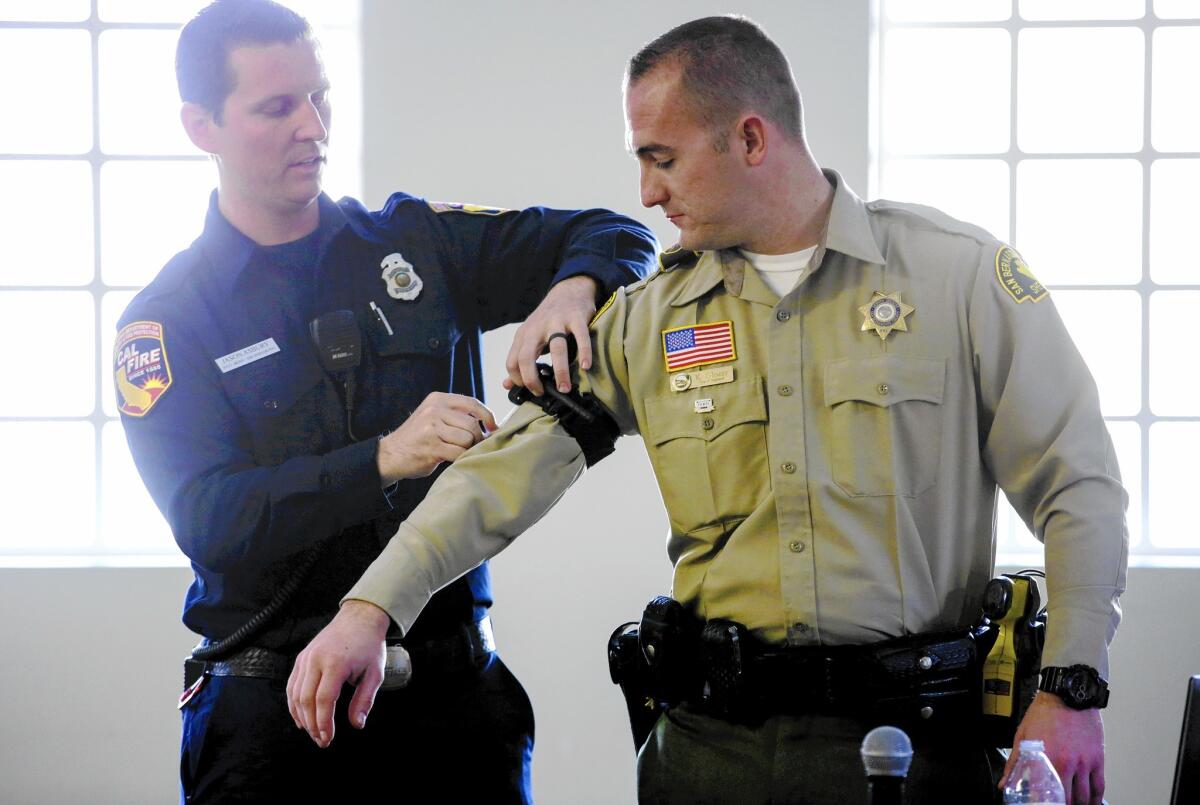After San Bernardino terror attack, many are attending active shooter trainings

- Share via
About the same time a couple opened fire at the Inland Regional Center in San Bernardino in December, Barbara Holmes’ son, who suffers from autism, was on his way there.
As she watched the news unfold on a department store TV, unsure if he had arrived and unable to contact him, she felt helpless.
Holmes eventually learned that her son was safe, having been diverted from the center before arriving. But she’s haunted by the powerlessness that overcame her that day.
She was one of dozens to attend an active shooter training hosted last weekend by the San Bernardino County Sheriff’s Department to teach the public what to do if confronted by a mass shooter.
“We need to learn these things now,” Holmes said. “Every parent should teach their children. … We’ve been living in a bubble.”
In the weeks since the mass shooting that left 14 people dead and 22 wounded, the Sheriff’s Department has held at least four active shooter trainings for the public and is planning more.
We need to learn these things now. Every parent should teach their children. ... We’ve been living in a bubble.
— Barbara Holmes, attending active shooter training
One recent event in Highland, a small city bordering San Bernardino that contracts with the Sheriff’s Department, drew a standing-room-only crowd of about 60 people, deputies said. The training the following day, which Holmes attended, drew about 30.
“Anxiety is up throughout the region,” said Highland Police Capt. Tony DeCecio, “People want to know what to do.”
During the two-hour session, local deputies provided information about terrorist groups, tips on emergency first aid and offered the suggestion: “Run, Hide or Fight” if confronted by a shooter.
That advice has been promoted in recent years by the Department of Homeland Security and the FBI as a way to respond to active shooters. A federally funded video based on it has been viewed nearly 4.5 million times, and an alert telling people to “Run, Hide or Fight” was issued recently by Naval Medical Center San Diego after someone mistakenly reported a shooting there.
In Highland, as attendees had coffee and doughnuts, many said they felt an urgent need to prepare for a future shooting.

“I know a lot of times the difference between saving your life and not would be an understanding of what your best options are,” said Jesse Carrillo, who attended with his wife, Angelina.
The training was led by a 14-year veteran, Deputy Danny Rice, who DeCecio said was asked to lead because “he knows how to fight and survive.”
In 2012, Rice was shot while on duty; he shot and killed the man who attacked him. He brought to the training the jeans he wore that day, which sat on a back table with two bullet holes in the right leg.
Toward the start of the session, a deputy asked the crowd if anyone wanted to know about carrying a concealed weapon. Several people raised their hands.
Since Dec. 2, the department has been flooded with applications and the wait to obtain a permit is now eight to 10 months, compared with two or three months earlier, he said.
Anxiety is up throughout the region. People want to know what to do.
— Highland Police Capt. Tony DeCecio
Deputy Kyle Glozer offered a slide show on terror groups: white supremacists, Al-Qaeda, Islamic State and the Sovereign Citizens movement, whose members are anti-government.
Glozer urged the crowd to be vigilant and to speak up about suspicious things, showing photos of a backpack abandoned near an escalator and a parked car with a propane tank sitting on the passenger side.
“I’m paranoid. Openly paranoid,” he said. “Our No. 1 enemy is denial. You think it’s never going to happen to you.”
He displayed the slick-looking covers of English-language magazines produced by ISIS, Al-Qaeda and other terror groups.
“If you were to see this on someone’s nightstand, you probably wouldn’t think anything of it,” he said.
Rice showed surveillance video of the shooter roaming the halls during the 2013 Washington Navy Yard shooting, in which 12 people were killed. It was followed by video of people running and crawling as attackers roam a shopping mall in Nairobi, eventually killing 67 people. Later, he showed footage of students hiding under tables during the 1999 attacks at Columbine High School in Colorado.
“What are you going to choose to do?” he asked the crowd.
Rice recommended learning combat tactical breathing to calm yourself in an attack, which, he explained, involves breathing in for four seconds, holding your breath for four and exhaling for four. He also offered tips such as wrapping a belt around the springs of a door to keep someone from coming in, and turning off lights and cellphones when hiding.
See more of our top stories on Facebook >>
Anything can be a weapon, he said — a chair, a book, a pen.
Finally, Deputy Cory McCarthy offered emergency medical tips, in which he emphasized using direct pressure to stop bleeding.
“Control the bleeding and get out,” he said. “That shooter may be somewhere around.”
After the training wrapped, Rice said he wanted people to “open their minds to the possibility that this can occur.”
“Fires, earthquakes. We’re prepared for that. But we want to deny this will ever happen,” he said. “It already has.”
Twitter: @palomaesquivel
ALSO
L.A. developers accused of stealing millions in affordable-housing scheme
Winter gone? Temperatures nearing 90 degrees in Southern California with gusty winds
More to Read
Sign up for Essential California
The most important California stories and recommendations in your inbox every morning.
You may occasionally receive promotional content from the Los Angeles Times.











